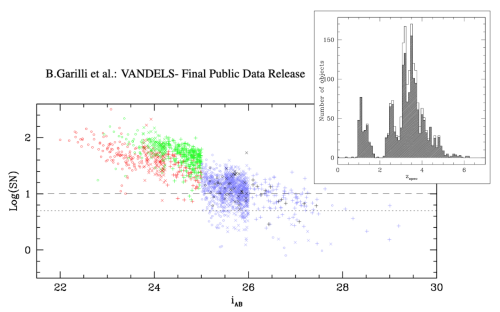The fourth and final data release of the deep VIMOS survey of the CANDELS UDS and CDFS fields, VANDELS, is now available in the ESO Science Archive Facility. The VANDELS survey (Programme id 194.A-2003, PI L. Pentericci and R. McLure) started data acquisition in November 2014 and was completed in March 2018 before the VIMOS decommissioning. It delivers high signal-to-noise (range: 10 -100), medium resolution (R~600) optical spectra (4800-10000 Å) for galaxies in the UKIDSS Ultra Deep Survey (UDS) and Chandra Deep Field South (CDFS) survey fields. The total area covered is 0.2 degree2.
Fourth - and Final - Data Release of the Spectroscopic Public Survey VANDELS

Using robust photometric redshift pre-selection, VANDELS targeted ≈2100 galaxies in the redshift interval 1.0<z<7.0, with 85% of its targets selected to be at z≥3. VANDELS also targeted a substantial number of passive galaxies in the redshift interval 1.0<z<2.5. The magnitude range of the sample is HAB<24 for star-forming galaxies in the redshift interval 2.5<z<5.5, HAB<27 for Lyman-break galaxies (LBGs) in the redshift interval 3.0<z<7.0, and HAB<22.5 for passive galaxies at redshifts 1.5<z<2.5.
Each target received between a minimum of 20 hours and a maximum of 80 hours of on-source integration time. The legacy of VANDELS consists of determining the key physical properties of high redshift galaxies such as their stellar population ages, metallicities and outflow velocities from detailed absorption-line studies.
This fourth data release consists of 2165 spectra (downloadable via the ESO Science Portal or programmatically), 1061 spectra in CDFS and 1104 in UDS field, respectively. DR4 totally replaces all products released in DR3 because of the new flux correction applied in the blue wavelength. In addition, DR4 provides 287 new spectra and 104 spectra of serendipitously observed objects.
In addition to the 1D spectra, this final release contains also the catalogue with spectroscopic redshifts and the derived physical properties for each galaxy. The catalogue can be queried via the Catalog Facility or TAP.
More information about the release content can be found in the accompanying documentation and in Garilli et al., 2021, A&A, in press, arXiv:2101.07645.
